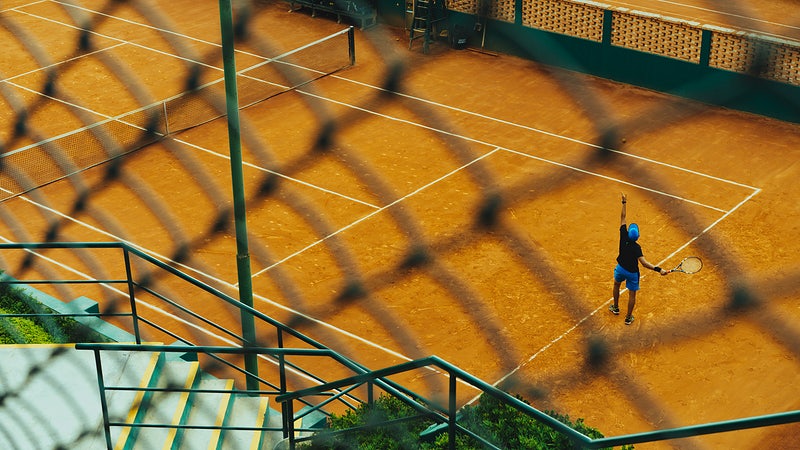Sports
Emma Raducanu thanks ‘role model’ Lewis Hamilton for support

Source: ESPN
U.S. Open champion Emma Raducanu has thanked Lewis Hamilton for his advice and support since her thrilling maiden Grand Slam win in September, describing the seven-times Formula One world champion as her role model.
Speaking after her straight-sets win over Elena-Gabriela Ruse at an exhibition event in London on Sunday, Raducanu said Hamilton was a “really cool guy”.
Raducanu competed in karting and motocross events as a child, and is a big fan of Formula One.
“(Hamilton) said: ‘Be patient, you’ve just got to ride the wave. It’s all good. Don’t worry’. Good reassurance. He has been such a good role model for me in terms of helping me out through the next stages,” Raducanu told British media.
The 19-year-old also shrugged off talk of beating Hamilton to the BBC Sports Personality of the Year award next month
“No, definitely not. I am rooting for Lewis in the race,” she said.
“I just don’t even think about it. For me, it’s something that’s so far out of the realms of possibility.”
Raducanu, who is preparing for the 2022 season by undergoing intense five-hour daily training sessions, also spoke about her personal goals.
“For me, my expectations of myself are to keep improving, I want to look back at the end of the year and see that I made gains in different areas. I know it will take a lot of patience to get to where I want to be,” she said.
The match on Sunday was Raducanu’s first on home soil since her astonishing U.S. Open triumph, when she entered the tournament as a qualifier ranked 150th in the world and ended it as Britain’s first female Grand Slam champion for 44 years.
You may like
Auto
The competition of simulation in motorsport development

Salman Safdar, subject matter expert at Ansible Motion
The automotive and motorsport industries have long been driven by the relentless pursuit of performance, efficiency and innovation and as these sectors evolve, so do the tools and technologies that support them.
Among these, Driver-in-the-Loop (DIL) simulation stands out as a transformative force, offering unprecedented opportunities for development, testing and optimisation. From motorsport through to broader automotive OEM applications, the integration of advanced simulation tools is undoubtedly accelerating progress and redefining the boundaries of what’s possible.
At the heart of all effective simulation is the interaction between humans and technology. High-fidelity simulators provide drivers with realistic feedback that closely matches what they would experience in the real world – an approach that’s vital for optimising performance and gaining that all-important competitive edge.
The ability to simulate multiple racing cars and series underscores the versatility of modern simulators. By allowing extensive and varied test programs to be conducted in a controlled environment, teams can make quick setup changes, explore various chassis configurations, and understand track conditions without the expense and time constraints of on-track testing. This not only strengthens the collaboration between drivers and engineers but also enhances the overall development process.
Only recently, topflight motorsport teams Penske Autosport and Honda Racing Corporation USA (HRC) announced their respective investments in DIL simulation – with HRC upgrading its simulator in time for this year’s Indianapolis 500.
Capable of replicating the current Dallara-Honda Indy car, Acura ARX-06 hybrid GTP machine and a variety of Honda and Acura concept racing vehicles, Ben Schmitt, head of the Vehicle Performance Group at HRC US explains in the firm’s official press release: “The new simulator is superior in every way to our original DIL simulator. The vehicle physics models have continued to evolve from the original simulator, including the tyre models, and our data acquisition capabilities are exponentially higher than previously. The new motion platform, cockpit and vision systems create a vehicle dynamics experience for the drivers that is our closest recreation yet of real-world conditions.”
Realism is also key for those competing in the FIA ABB Formula E Championship – providing a data-rich environment where drivers can learn track layouts, optimise energy management strategies, and experiment with different race scenarios.
When it comes to gaining a competitive edge – on and off the track – engineers and drivers are looking for tools they can trust, and DIL offers the ability to replay and analyse multiple scenarios repeatedly, via a truly immersive experience that mirrors real-world conditions. However, engineers also need the capability to connect with a vehicle’s onboard powertrain ECUs via Hardware-in-the-Loop (HIL) and Software-in-the-Loop (SIL) systems – integration which facilitates the validation of critical components such as torque maps and electro-mechanical driver controls, ensuring that both the hardware and software are finely tuned before hitting the track.
One of the standout features of contemporary simulation environments is their ability to integrate with other advanced tools such as engineering-grade visual simulation environments – crucial for teams that need to adapt quickly to changing conditions. For example, there’s no need to wait for a real rainstorm because weather variations can be conjured up with the touch of a button; multiple tyres can be driven in rapid succession; a virtual racetrack can even be set up to loop one particularly critical track segment continuously.
While motorsport often leads in adopting cutting-edge technologies, the benefits of simulation extend well beyond the circuit. Automotive manufacturers are increasingly leveraging simulation to enhance vehicle development processes, reduce costs, shorten development cycles and reduce the environmental impacts inherent in the traditional build-and-test approach.
As the automotive and motorsport industries continue to evolve, the role of simulation will only become more critical thanks to its ability to provide a controlled, repeatable, and data-rich testing environment that is flexible as well as sustainable.
Whether it’s mastering the intricacies of a demanding street circuit or refining the dynamics of a new road car, simulation offers unparalleled opportunities to innovate and excel. As we look to the future, the seamless integration of these tools will undoubtedly expedite progress and set new standards for excellence in both motorsport and automotive development.
Sports
Intelligent Automation and Football: How Lessons from the Pitch can Enhance Automation Initiatives

Neil Murphy, CSO, ABBYY
Football is the most watched sport in the world, with an international passion for the game resulting in some unexpected intersections of culture and commerce. Ted Lasso follows an American football coach’s journey to leading an English Premier League team. Although Ted’s endearing quips and southern drawl might have been mere comedic caricature, the trope of westerners meddling in European football is no longer just fiction.
American actors Rob McElhenney and Ryan Reynolds bought English football club Wrexham AFC in November of 2020 for £2m, funding the club’s return to the English Football League for the first time since their relegation over a decade prior. More recently in May of 2023, professional American athletes J.J. and Kealia Watt became minority owners of Burnley Football Club in England.
Now, ABBYY is partnering with Arsenal Women’s Football Club, elevating the trend of western investment from just wealthy individuals to notable technology enterprises.
As enthusiasm for football continues to grow worldwide, these intersections become inevitable, but they’re much more than household celebrity names or mere sponsorship deals. On the surface, using advanced AI within automation solutions might seem like a concept far removed from the sport of football – but this technology has much more in common with what occurs on the pitch than you might think.
Strategy and intent – moving with a purpose
Football is all about control. Without a proper strategy in mind, the ball could easily be taken by a defender, or fall into the hands of the goalkeeper, turning the tide of the game against you in an instant.
Similarly, implementing automation without a clear objective or understanding of your organisation’s current processes will not always yield desirable results. Without proper visibility, you could unintentionally make a bottleneck more visible to the customer, dampening their experience without any gains in efficiency. This isn’t uncommon – 70% of automation attempts fail due to unclear goals.
Understanding your scoring strategy from end to end is crucial to maintain control over your processes, which requires deep familiarity with both your team dynamics and individual traits. Process intelligence, or the practice of driving process improvement through use of advanced data analytics,enables this visibility by combining process mining and task mining into a unified, AI-enhanced platform. While task mining examines individuals’ workflows like clicks and keystrokes, process mining scrutinises the larger holistic process. Much like understanding individual football players’ mechanical skill such as footwork, positioning, and ball control as well as how each player interacts with one another is key to devising an informed strategy, combining insights from task and process mining yields the most contextually accurate model of how a process or workflow can be improved.
Proving it on the pitch
Football fans’ expectations for their respective clubs can reach astronomical heights in the off season, often fueled by the acquisition of up-and-coming talent. While new promises of success can be exciting, not every team will perform as well as we expect them to.
The intelligent automation market experiences a similar trend. The constant upcropping of startup vendors trying to capitalise on the hype train of AI can be overwhelming, with each of them boasting unprecedented potential for efficiency gains without ever having experienced the real pressures of operating a modern enterprise. On the other hand, massive tech-giants will try to leverage their brand recognition and resources to win you over, despite their unfamiliarity and overall detachment from your specific business needs.
It’s unadvisable to jump the gun and sign the rising star that promises to transform your operations without any gametime experience, just as it’s unwise to shell out cash to the household name with an illustrious legacy that’s becoming weak in the knees and slow to keep up. When selecting a provider of intelligent automation solutions, you need to prioritise both innovation and experience, and most importantly, an understanding of and commitment to your organisation’s needs. Haphazardly filling your tech stack with every new tool that promises to yield the best value from AI will create a cacophony of platforms, inhibiting efficiency – take care in selecting your solutions and choose those that have proven their worth in the context of the modern enterprise.
Improving outcomes and predictability through training
There’s no denying that “practice makes perfect.” Dribbling, passing, corner-kicks; even professional players practice the basics every day to stay sharp and dependable on the pitch.
Intelligent document processing (IDP), or the application of AI and machine learningto understand, process, and extract insights from business-critical documents like a human, works similarly. By processing volumes of documents, it hones its accuracy in extracting key information over time. This improves its straight-through processing rate, or the rate at which it can process a document with 100% accuracy without any manual intervention. Leveraging IDP allows professionals to spend less time on repetitive, monotonous manual data entry, empowering them to focus on more fulfilling or customer-facing tasks.
But what if there are more advanced or specific skills you’d like to cultivate within your team, such as bicycle kicks or intricate passing maneuvers? The answer is simple – drill those specific skills, giving your team even more versatility.
With IDP, you can augment your platform with pre-trained document skills that are developed to handle a multitude of specific documents that might be crucial to the full scope of your business. From hyper-specific government forms in Japan that vary per district to US tax forms with seemingly countless variables, IDP can be trained to extract actionable data with staggering accuracy.
Weaving a strong fabric
In sport and business, teamwork is everything. Just as Ted Lasso worked tirelessly to fix Richmond’s tumultuous team culture to bring out the best in his players and weave a strong fabric from their strengths, intelligent automation solutions help drive progress forward at a unified pace.
Adopting a unified suite of automation technology ensures that no facet of your operations will fall behind. It’s impossible to fully benefit from the visibility and insight enabled by process intelligence if you don’t have the technological capability to improve cumbersome document-centric processes. On the other hand, it’s difficult and unadvisable to leverage IDP haphazardly without evaluating where it is most needed.
Bringing the victory home
Intelligent automation and the sport of football couldn’t be any more different on paper, but those with a keen eye for strategy, teamwork, and culture will see the value in applying these to innovation. Implementing intelligent automation doesn’t have to be dauntingly ambiguous – with the right coach at the helm and the right players on the metaphorical pitch, you can assure victory for your organisation.
Lifestyle
Exploring the psychological impacts of a two-month, solo Antarctic expedition

Next month, British explorer Sam Cox will spend two months, completely alone, trekking across one of the Earth’s last true wildernesses – Antarctica.
While travelling 2,000km across snow and ice requires a huge amount of physical endurance, the mental impacts of this journey are perhaps, even more significant.
Alexandra de Carvalho from the Austrian Space Forum will be working closely with Sam pre- and post-expedition, to understand the psychological impacts of the journey.
“The first thing to consider is the sheer isolation of this challenge. Two months with extremely minimal human contact is not something to be underestimated,” she said.
“Our work is mainly concerned with space, and people usually think that space is more distant than Antarctica, but actually it’s not true. It’s much easier sometimes to come back from space, to come back to Earth if there’s an emergency.
“More people have gone into space than trekked to the South Pole.
“To come back to the mainland from Antarctica can be extremely difficult, which exacerbates that feeling of distance. You cannot just be evacuated if you want.”
The only link Sam will have to the outside world is a beacon plotting his incremental location in case of emergency, and very limited communications via satphone.
Alexandra added: “Separated from family and friends, this kind of study will help to really understand more about the psychology of people.
“In fact, this is the main reason we were so keen to work with Sam. He’s in a very special situation, being alone with nobody to share his feelings with, nobody to share his thoughts with.
“It’s rare that scientists can study subjects that are completely isolated for this amount of time, let alone in conditions as extreme as those in Antarctica.
“We really want to get an idea how a person emotionally regulates in this kind of scenario.”
Sam will be taking daily voice recordings of the experiences and emotions he’s feeling during this period of extreme isolation.
Alexandra said: “For this research to be useful, it’s really important that we hear frequent and specific audio diary entries from Sam.
“It’s common for people to look back on an experience like this and say – it was stressful, but it was nice – which is not precise enough for us.
“We’re using audio equipment to make this as accessible for Sam as possible – writing could be a challenge in extremely low temperatures.
“In similar studies, we’ve asked participants to keep written diaries as the fear of being overheard by other participants might stunt their honestly, but that’s not going to be an issue with Sam, since he’ll be completely alone.”
There will be other psychological challenges for Sam, as well as isolation.
Sam said: “An important thing to consider is the 24-hour daylight, and how my body will adapt to that.
“Because I’m travelling during Antarctica’s summer months, the sun will never actually set, meaning my circadian rhythm is likely to get pretty confused.
“A lack of sleep could be detrimental to my physical and mental well-being, so it’s something I’m having to prepare for.”
Alexandra said: “Sensory deprivation could also be a challenge. It’s an interesting environment, but it’s very monotonous, so it depends on the person and how they perceive it.
“For example, Sam might find it interesting to have the colour green. While other people would be fascinated by the sky and the sea, he might be like wow – I really miss the forest and more complex environments.”
Alexandra continued: “This research is not only helping us understand the emotional impact of extreme environments, but it’s helping us understand the type of person that’s suitable for working in these remote places.
“We want to know how people feel in these environments, which emotions are more dominant? How do these people deal with that?
“When people are stationed in distant locations, either from Earth or in polar expeditions, they have to be really trained to deal with their feelings autonomously.
“But we can only do that by understanding when happens within a person and what they’re likely to feel so we can prepare them beforehand. You can prepare, but you cannot run away from your emotions.”
Sam leaves the UK for Antarctica on 24th October, with plans to complete the expedition by mid-January.
He has been supported by Team Forces and Resilient Nutrition to embark on this epic adventure.
For more information, follow Sam on www.frozendagger.co.uk

Stealthy Malware: How Does it Work and How Should Enterprises Mitigate It?

How 5G and AI shaping the future of eHealth

Driving business success in today’s data-driven world through data governance

The Sustainability Carrot Could be More Powerful Than the Stick!

Hybrid cloud adoption: why vendors are making the switch in 2022 and why you should too


